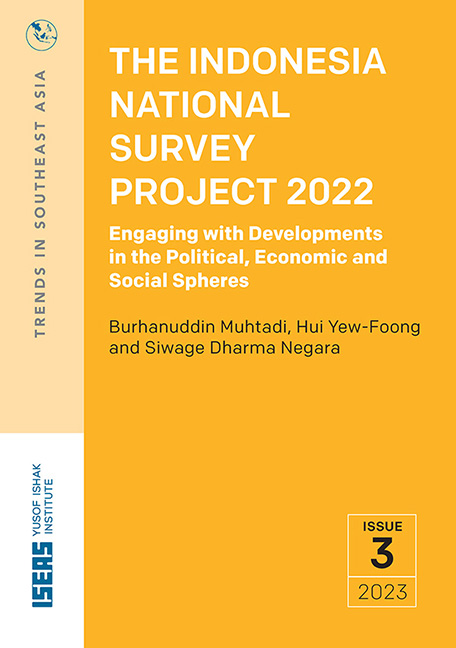 The Indonesia National Survey Project 2022
The Indonesia National Survey Project 2022 Book contents
- Frontmatter
- Foreword
- Table of Contents
- List of Figures and Tables
- The Indonesia National Survey Project 2022: Engaging with Developments in the Political, Economic and Social Spheres: Executive Summary
- 1 The Indonesia National Survey Project 2022: Engaging with Developments in the Political, Economic and Social Spheres: Introduction
- 2 Politics
- 3 Economy
- 4 International Relations
- 5 Society
- 6 Current Issues
- 7 Conclusion
5 - Society
Published online by Cambridge University Press: 09 January 2024
- Frontmatter
- Foreword
- Table of Contents
- List of Figures and Tables
- The Indonesia National Survey Project 2022: Engaging with Developments in the Political, Economic and Social Spheres: Executive Summary
- 1 The Indonesia National Survey Project 2022: Engaging with Developments in the Political, Economic and Social Spheres: Introduction
- 2 Politics
- 3 Economy
- 4 International Relations
- 5 Society
- 6 Current Issues
- 7 Conclusion
Summary
Islamic Religious Practices
This subsection looks into the influence of Islam on society, especially in the context of Indonesia being a Muslim-majority country. Muslims constitute 91.1 per cent of the sample, and their responses are what we examine here.
The majority of Muslim respondents “often” or “always” carry out their obligatory acts of worship, such as fasting during the month of Ramadan (93 per cent), performing the obligatory daily prayers (80.2 per cent), and observing Friday prayers (47 per cent, but if we only consider men, the figure rises to 83.7 per cent). Meanwhile, in terms of paying tithe (zakat mal) and giving alms, 53.8 per cent and 70.9 per cent “often” or “always” observe these practices respectively. In contrast, due to the high cost of performing the haj and umrah, more than 90 per cent of Muslim respondents have never performed these pilgrimages.
The majority of Muslim respondents (69.8 per cent) are of the opinion that all Muslim women should wear the Islamic headscarf or hijab, while 22.3 per cent leave the decision to the individuals, and 8 per cent feel that Muslim women do not have to wear the hijab. Interestingly, the view that Muslim women must wear the hijab is slightly more likely to be held by female than male respondents, and by rural respondents and respondents of low and medium income (Figure 21).
In terms of practice, 61.9 per cent of Muslim women respondents claim that they usually wear the hijab, while 34.9 per cent wear the hijab depending on the situation, and only 3.3 per cent do not wear the hijab (Figure 22).
The majority of Muslim respondents (88.6 per cent) agree that implementing Islamic law will bring benefits to society, especially in terms of strengthening moral values (62.5 per cent), although this latter figure has dropped from 67.2 per cent as per the INSP2017 (Figure 23). Other perceived benefits, such as the spread of Islam (11.8 per cent), increasing public security (8.9 per cent), and helping to eradicate corruption (5.4 per cent), approximate the level of responses for the INSP2017. Meanwhile, 11.4 per cent of respondents are convinced that the application of Islamic law brings very little or no benefit.
- Type
- Chapter
- Information
- The Indonesia National Survey Project 2022Engaging with Developments in the Political, Economic and Social Spheres, pp. 39 - 52Publisher: ISEAS–Yusof Ishak InstitutePrint publication year: 2023
